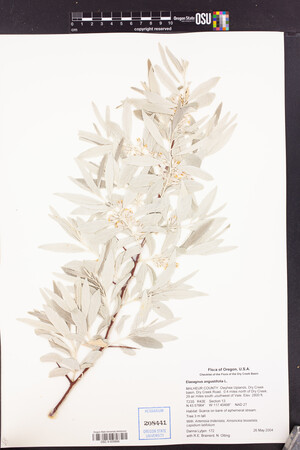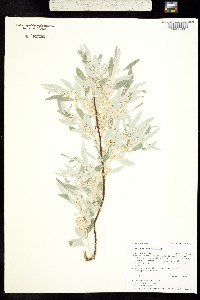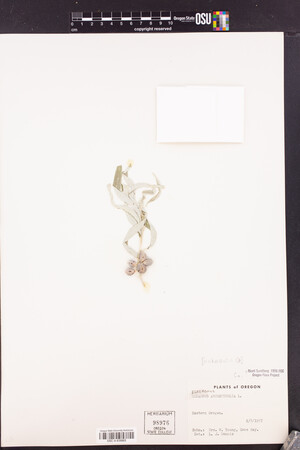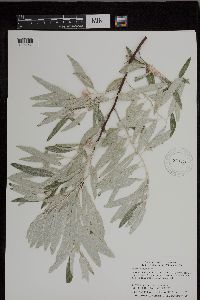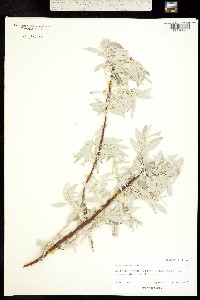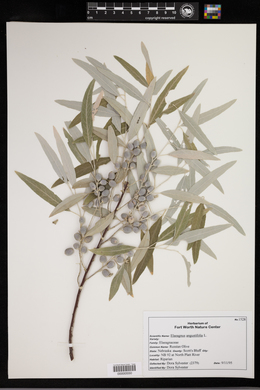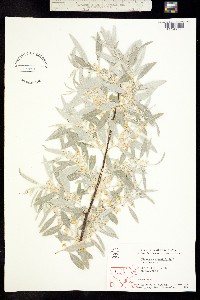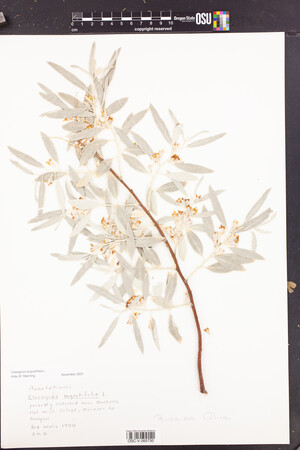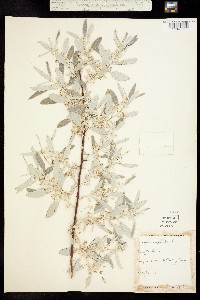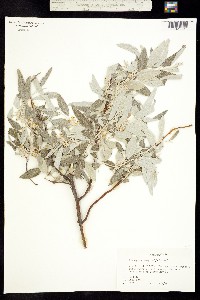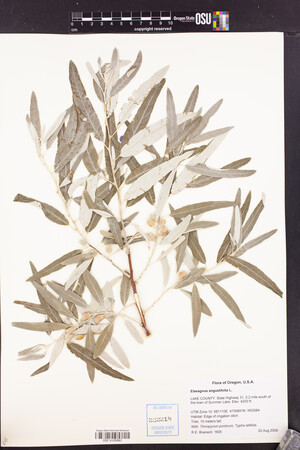Elaeagnus angustifolia
|
|
|
|
Family: Elaeagnaceae
Russian olive, more...Russian-Olive, oleaster
[Elaeagnus angustifolia var. angustifolia, moreElaeagnus angustifolia var. orientalis , Elaeagnus angustifolia var. spinosa , Elaeagnus hortensis , Elaeagnus hortensis subsp. moorcroftii (Wall. ex Schltdl.) Servett., Elaeagnus hortensis var. songorica] |
Large shrub or small tree to 10 m tall, as wide as tall Leaves: alternate, dark green with silver scales above, covered with silvery white scales beneath, 4 - 10 cm long, 1.2 - 2.4 cm wide, lance-shaped with a pointed tip, non-toothed. Flowers: solitary or in clusters of two to three near leaf axils, silver to white outside, yellow inside, calyx tubular and four-lobed, lacking petals, fragrant. Fruit: fleshy with an achene in the center, short-stalked, yellow, covered with silvery white scales, 1 - 1.5 cm long, egg-shaped. Twigs: covered with silver scales when young, becoming shiny and brown with age, sometimes thorny. Buds: grayish brown, tiny, rounded to oblong, with silvery scales. Similar species: All species of the Elaeagnaceae family in the Chicago Region have silvery white leaves with non-toothed margins, flowers with a tubular calyx and no petals, and berry-like fruit. Shepherdia canadensis is a 1 - 3 m tall shrub with opposite leaves, while species of Elaeagnus have alternate leaves. Elaeagnus umbellata is a 5.5 m tall shrub with often spiny twigs, elliptic to oblong-egg-shaped leaves with green upper and silver lower surfaces, a calyx tube longer than calyx lobes, and red fruit on a stalk to 1 cm long. Elaeagnus multiflora is a 2 m tall shrub that has elliptic to egg-shaped leaves with green upper and silver lower surfaces, equal length calyx tube and lobes, and red fruit on a 1.5 - 2.5 cm stalk. Flowering: June Habitat and ecology: Rarely escapes from cultivation into sunny areas of wild meadows, old fields, and along highways and railroads. This species is adaptable to many soil conditions, is drought and salt tolerant, and has a symbiotic relationship with nitrogen-fixing bacteria. Occurence in the Chicago region: non-native Notes: Elaeagnus angustifolia was introduced from Eurasia for use in windbreaks and soil reclamation. It also became somewhat popular in the landscape due to its silvery foliage. The species does not escape frequently in the Chicago Region but is labeled as invasive elsewhere, especially in the western United States. Etymology: Elaeagnus comes from the Greek words elaia, meaning olive, and agnos, meaning pure, referring to the resemblance of the fruit and foliage to a true olive, Olea sp. Angustifolia comes from the Latin words meaning narrow-leaved. Author: The Morton Arboretum Welsh et al. 1993, Martin and Hutchins 1980, USFS FEIS accessed 2015, Heil et al 2013, Carter 2012 Common Name: Russian olive Duration: Perennial Nativity: Non-Native Lifeform: Tree Wetland Status: FAC General: Fast-growing tree or shrub, up to 12 m tall; bark shreddy and gray; branches reddish, often armed with thorns. Leaves: Alternate on branchlets, on petioles 4-8 cm long; blades lanceolate, 3-10 cm long and about 1 cm wide, the upper surface bright green and the lower surface silver with dense, minute scales; leaves are autumn-deciduous. Flowers: Yellow and solitary or in clusters of two to three near leaf axils, very fragrant; hypanthium 1 cm long, stellate-hairy and silvery; petals 4, yellow. Fruits: Olivelike drupe, 1-2 cm long, yellow-orange. Ecology: Found near human disturbance, often around springs, seeps, irrigation ditches, and riparian zones; in the Southwest is is generally found from 3,000-7,000 ft (914-2134 m); flowers May-June. Distribution: Native to Eurasia, naturalized in North America; found throughout the Western, Midwestern, and Northeastern US and southern Canada. Notes: Distinguished by the thorny, reddish younger twigs; the silvery, oblong, two-tone leaves; yellow flowers 1 cm long; and orange olive-like berries. Russian Olive was introduced into the Americas as a horticultural plant. It has been valued as a landscaping plant and used for windbreaks, snowbreaks, soil stabilization, wildlife habitat, and pollen for honeybees. Its planting was recommended for windbreaks during the Dust Bowl of the 1930's. From the 1930's to the 1960's, the species spread from cultivation and naturalized throughout the Great Plains, Intermountain West, and Southwest US, where it is now considered a pest. It is present in the eastern US but is not considered invasive there. Ethnobotany: Used as folk medicine for bronchitis and fever in Syria. Etymology: Elaeagnus is from the Greek elais for olive, and agnos, the chaste-tree, while angustifolia means having narrow leaves. Synonyms: Elaeagnus angustifolia var. orientalis Editor: AHazelton 2017 Small, usually thorny tree to 10 m, the young twigs densely silvery; lvs lanceolate, 3-10 cm, silvery on both sides; fls as in no. 1 [Elaeagnus commutata Bernh.], except the style surrounded by a short, tubular disk just above the constriction of the hypanthium; fr 1 cm, yellow, with silvery scales; 2n=28. Native of Eurasia, planted for ornament and often escaped in c. and w. U.S., rarely eastward. June, July. Gleason, Henry A. & Cronquist, Arthur J. 1991. Manual of vascular plants of northeastern United States and adjacent Canada. lxxv + 910 pp. ©The New York Botanical Garden. All rights reserved. Used by permission. From Flora of Indiana (1940) by Charles C. Deam Indiana Coefficient of Conservatism: C = null, non-native Wetland Indicator Status: FACU |











